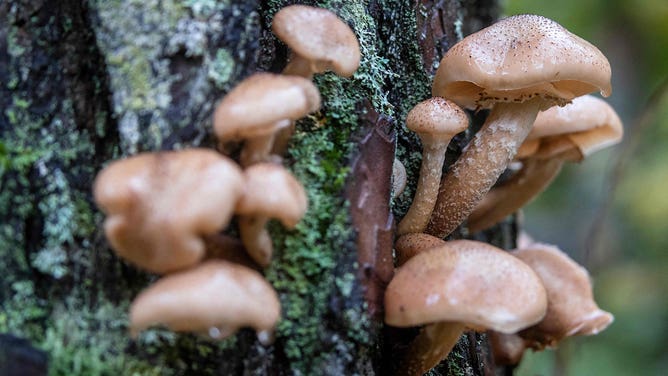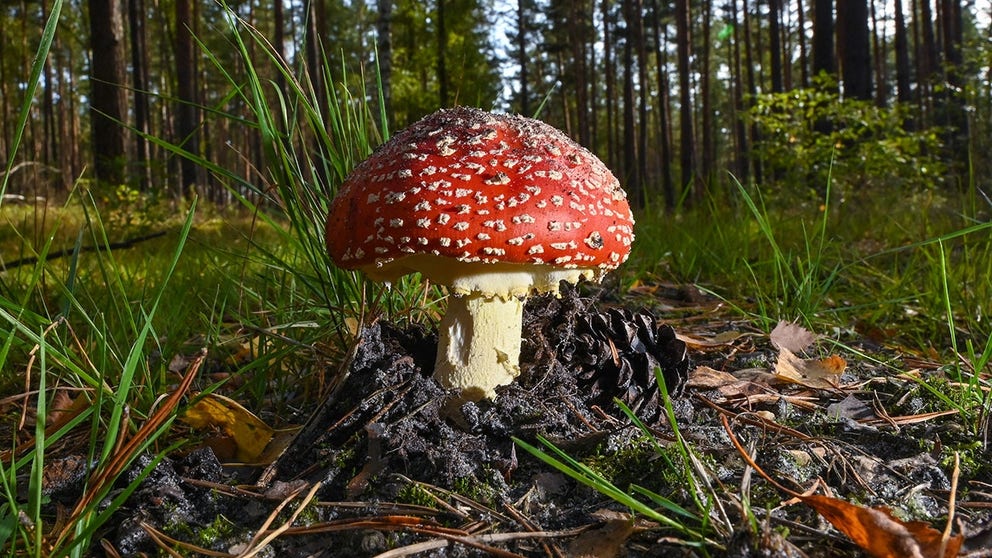Magic mushrooms: Scientist says fungi could revolutionize climate change fight
Fungi play an important role in the health of a forest and, in turn, affect its ability to absorb carbon dioxide from the atmosphere
How mushrooms can help fight climate change
Fungi play an important part in the health of forest ecosystems and their ability to fight climate change.
Visit any forest, and you’re bound to see mushrooms growing alongside trees and other plants, but these fungi play an important part in the health of that ecosystem and its ability to fight climate change.
Colin Averill, an ecologist and lead scientist at ETH Zürich, has been studying the relationship between fungi and forests for 15 years.
"Mostly because it seemed incredibly important, and yet, at the time, very few people were doing it," Averill said.
FARMERS FACE CLIMATE CHANGE BY RETHINKING THE AGE-OLD PROFESSION
Averill is specifically focused on what he calls the fungal microbiome of a forest. He said these fungi play a critical role in the health of every plant on Earth.
"My team and I study how, particularly, which microscopic fungi live on a tree's roots can affect how an entire force works, how fast trees grow, their ability to withstand drought and disease, how much carbon trees can capture and store in tree stems and in soils," Averill said.
Fungal partnership
Averill said the partnership between fungi and plants plays a critical role in how plants can access the soil-based nutrients and water they need to survive.
Their survival is important because plants act as nature’s air purifiers. They soak up carbon dioxide from the air and use it as a fuel for photosynthesis, the process that provides them with food. Plants then expel the oxygen they create during that process."
‘WE’RE BOXING IN THE LAST CHANCE SALOON’: HOW ONE COMPANY AIMS TO TAKE ON CLIMATE CHANGE
According to Averill, land-based ecosystems have absorbed about a third of all carbon dioxide emissions that humanity has emitted.
"In this way, you know, the land acts as a buffer in the global climate system and does us a huge favor in this regard," Averill said. "Forests and other natural ecosystems couldn't do this service without the help of their symbiotic root fungi, the mycorrhizal fungi, which are necessary for supporting forests with the nutrition they need to soak up all of this extra carbon dioxide."
Averill said some of these fungi have been linked to faster tree growth which can lead to more CO absorption.

Fungi and lichens are seen on a fallen tree are seen in the Bialowieza primeval forest near Teremiski village, Eastern Poland, on October 1, 2021.
(WOJTEK RADWANSKI/AFP via Getty Images)
When forests get sick
Another large part of Averill’s research has to do with mapping which fungi live in a particular forest and how that fungal balance plays a role in the overall health of that ecosystem. He said the research can be likened to medical research that showed the role gut bacteria play in a person’s overall health.
"That initial science became the foundation of new medical therapies that restore a person’s gut microbiology to treat those diseases," he said.
Averill said he and his team are trying to determine if a forest that has become weaker because of the loss of the fungi it needs to survive can be treated.
HOW TO WATCH FOX WEATHER ON YOUR TV
"Can we restore the forest’s fungal microbiome, and by doing so, build a healthier forest that can capture more carbon, that can better fight climate change?" he asked.
According to Averill, DNA sequencing has become more economical during the past five years and has allowed researchers to better map fungal microbiomes that call forests home. That information can then be used in the treatment research.
"We’ve established large-scale field trials in Mexico and Wales in the United Kingdom, where we’ve manipulated forest fungal microbiomes and are tracking outcomes for tree growth and carbon capture and carbon removal," Averill said.
Pollution and fungi
In addition to carbon dioxide, nitrous oxide is another pollutant that is produced when fossil fuels are burned. According to the Environmental Protection Agency, N2O also comes from agriculture and wastewater, and it accounts for about 7% of all greenhouse gas emissions in the U.S.
Averill said this N2O basically acts as a nitrogen fertilizer when it makes its way to forests and other ecosystems. While fertilizing forests may sound like a good thing, Averill said, not so fast.
"There are winners and losers in that process, but, essentially, it's radically changed which fungi live in the forest," Averill said. "Unfortunately, the fungi that have won happen to be those that are linked to forests storing less carbon in the ecosystem."

Fungi and moss are seen on fallen trees in the Bialowieza primeval forest near Teremiski village, Eastern Poland, on October 1, 2021.
(WOJTEK RADWANSKI/AFP via Getty Images)
A fungal ‘revolution’
Averill said he is convinced that understanding the role fungi play in plants’ ability to absorb and store carbon can help revolutionize the toolkit humanity uses to fight climate change.
"Fungi have the potential to enable really serious climate mitigation, and I want to emphasize that, right now, we’re only at the very beginning of this revolution," Averill said.
Averill has co-founded a company called Funga aimed at placing the right native fungi in the right forests. The goal is to create more resilient forests that can capture and store more carbon.
